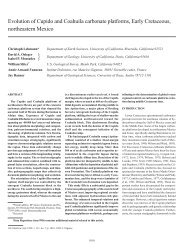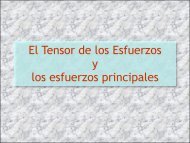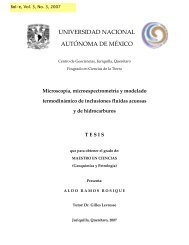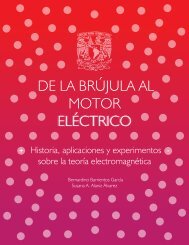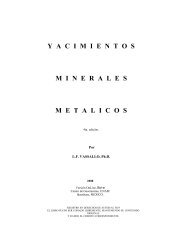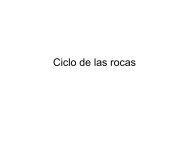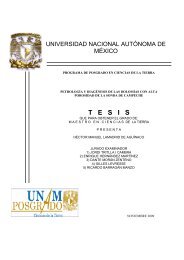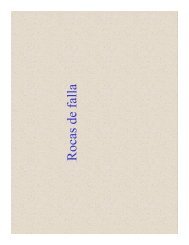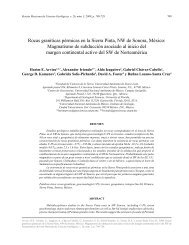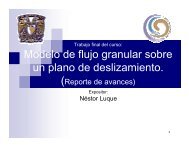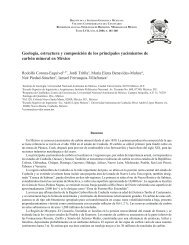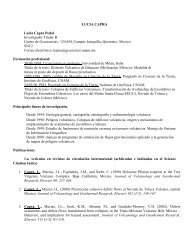Efrén Pérez Segura - Centro de Geociencias ::.. UNAM
Efrén Pérez Segura - Centro de Geociencias ::.. UNAM
Efrén Pérez Segura - Centro de Geociencias ::.. UNAM
Create successful ePaper yourself
Turn your PDF publications into a flip-book with our unique Google optimized e-Paper software.
Abstract<br />
xxiii<br />
The state of Sonora is the main producer of metals, minerals and industrial rocks in<br />
Mexico. Main production inclu<strong>de</strong>s copper, molyb<strong>de</strong>num, gold, graphite, baryte,<br />
wollastonite and limestone for cement. Porphyry copper, skarns (W, Fe and base metal), as<br />
well as epithermal and mesothermal gold <strong>de</strong>posits are the main types of ore <strong>de</strong>posits in<br />
Sonora. The present work <strong>de</strong>als about metallogeny of the La Esperanza skarn <strong>de</strong>posits in<br />
Sonora, which contains Ni and Co in economic ranges. La Esperanza is located to the north<br />
of Sierra Santo Niño (SSN) in Central Sonora. The SSN is a horst with an altitu<strong>de</strong> between<br />
400 and 1800 m.a.s.l. and it is bor<strong>de</strong>red by the grabens or semigrabens of the Yaqui and<br />
Bacanora rivers. The general geology of the SSN is characterized by a <strong>de</strong>tritic-carbonated<br />
paleozoic sequence, ranging from Carboniferous to Permian ages. These paleozoic series<br />
occurs like roof pendants over intrusive laramidic granitoids, sometimes the paleozoic<br />
sediments overthrust the an<strong>de</strong>sitic volcanic rocks of the Upper Cretaceous-Lower Tertiary<br />
Tarahumara Formation. Molase sedimentary <strong>de</strong>posits, similar to the Tertiary Báucarit<br />
Group, and related volcanic rocks fill up the Yaqui and Bacanora rivers tectonic bassins.<br />
The granitoid assemblage, named in the present work as the Moras-Novillo-Bacanora<br />
Batholith (MNBB), is probably a multiple intrusions complex batholith ma<strong>de</strong> of tonalitesgranodiorites-granites<br />
bearing biotite and hornblen<strong>de</strong> or, sometimes pyroxene. The San<br />
Lucas Porphyry (SLP) is a hypabisal or subvolcanic stock related to the magmatic activity<br />
of the MNBB; it has monzonitic to quartz sienitic compositio n and it is genetic and<br />
spatially related to the La Esperanza skarns. Major elements geochemistry for the MNBB<br />
shows the following ranges: SiO 2 55.1 to 71.1 %, Al2O3 14.8 to 16.9 %, Fe2O3, 2.3 to 7.4<br />
%, MgO 0 to 4.8 %, CaO 1.6 to 7.5 %, Na2O 3.2 to 4.9 % a nd K2O 2.1 to 4.0 %. In Harker<br />
diagrams we can observe a systematic <strong>de</strong>pletion for Al2O3, CaO, MgO, Fe2O3, TiO 2 and<br />
P2O5 with increasing SiO 2. Otherwise, trace elements of the MNBB show positive<br />
correlations for Sr/Rb, Sr/Ni and Sr/Cr, according with the differentiation rocks <strong>de</strong>gree. The<br />
major elements ranges for the SLP are as follow: SiO2 63.1 to 67.9 %, Al2O3 15.3 to 16.0<br />
%, Fe2O3 1.1 to 4.3 %, MgO 0.0 to 2.0 %, CaO 1.8 to 2.6 %, Na2O 3.9 to 5.3 % and K2O<br />
3.9 to 6.8 %; the SLP becomes poorer in MgO, TiO 2 and P2O5 with increasing SiO2. The<br />
REE pattern indicates enrichment in LREE and <strong>de</strong>pletion in HREE for the MNBB and SLP.<br />
Sr and Nd isotopic data let us calculating 87 Sr/ 86 Sri of 0.7066 and an ?Ndi of –4.6 for the<br />
BMNB and a 87 Sr/ 86 Sri of 0.7070 and ?Ndi of –6.1 for the SLP; while mo<strong>de</strong>l ages related to<br />
<strong>de</strong>pleted mantle (TDM) are respectively 1.05 and 0.97 Ga. These isotopic data are similar<br />
to other granitoids in Central Sonora and are interpreted as a result of continental crust<br />
contamination. U-Pb and Ar/Ar geochronologic data on the MNBB and SLP indicate a<br />
magmatic pulse trough 90 Ma not reported before in Central Sonora; and another magmatic<br />
stage trough 62 Ma. These ages let us to propose that paleozoic platform overthrusted the<br />
an<strong>de</strong>sitic rocks of Tarahumara Formation between 100-90 Ma, since granitoids are intrusive<br />
in both sedimentary and volcanic rocks. Geochemistry characteristics of the MNBB and<br />
SLP, mainly related to REE behavior and Y, Sr/Y, YbN y (La/Yb)N values, situate these<br />
rocks in the adakitic field, originated from magma compatible with garnet-hornblen<strong>de</strong><br />
restite, partially contaminated by continental crust and the mantle edge. The La Esperanza<br />
ore bodies are constituted by some skarns, <strong>de</strong>veloped on the SLP and paleozoic limestones<br />
contact. Los Rieles, El Barranco, El Tigre and La Reyna are the main i<strong>de</strong>ntified bodies.<br />
Economic exploration is poor, however preliminary resources can be estimated on 1 Mt



